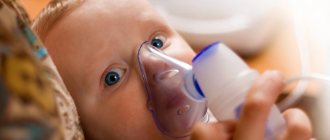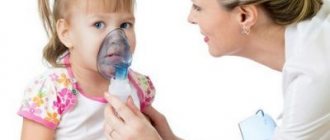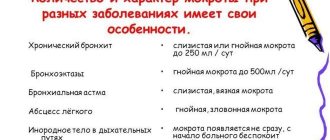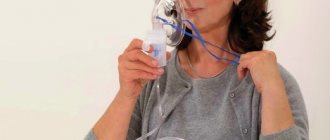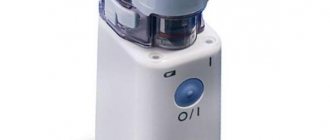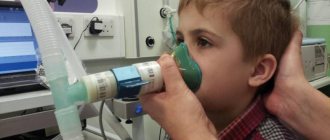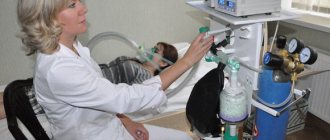Sore throat is an acute infectious and inflammatory process affecting the palatine (in most cases), less often the tubal, lingual, or pharyngeal tonsils. The causative agents can be bacteria, viruses, and fungi. Another name for the disease is tonsillitis.
The pathology begins with signs of ARVI - increased temperature, sore throat and sore throat when swallowing. It is better to start treatment at the initial stage to avoid the spread of infection to the entire nasopharyngeal cavity and respiratory tract.
Inhalation in the treatment of sore throat is an effective and affordable method of therapy, since the procedures can be performed at home, for adults, children and pregnant women, without fear of serious consequences for the body.
Benefits of nebulizer therapy
Inhalations for tonsillitis, which are carried out using a nebulizer, have many advantages over the ingestion of systemic drugs:
- etiotropic effect - the use of antibacterial drugs in a nebulizer in many cases replaces the use of systemic antibiotics, which have a lot of side effects. Preparations for inhalation with a nebulizer for angina do not enter the general bloodstream, the toxic effect on the liver, kidneys and internal organs is reduced, and the effect is observed directly at the site of inflammation. Recovery often occurs without the need for oral or injectable antibiotics;
- reducing the duration of the acute phase of the disease;
- reducing the dosage of tablets;
- prevention of complications from the trachea, throat, ligaments;
- reducing signs of obstruction and allergic edema of the larynx;
- moisturizing and cleansing the throat mucosa from pathological plaque, providing an anti-inflammatory and antimicrobial effect at the same time;
- ease of use in the treatment of young children - psychological discomfort is reduced, since there is no need to give injections or take bitter medicines. Using a mask allows the child to undergo the procedure even while sleeping.
Another undeniable advantage of the inhalation effect is the simultaneous treatment of not only sore throat, but also associated symptoms of the disease - rhinitis, cough, obstructive syndrome (these symptoms are often accompanied by tonsillitis).
To get rid of a runny nose, it is better to use a mask rather than a mouthpiece and inhale the medicine alternately through the nose and mouth, especially when using alkaline solutions in therapy.
What are the benefits of inhalation with a nebulizer for sore throat?
A nebulizer in the treatment of sore throat provides a complex effect on the patient’s health. Among the beneficial properties of inhalation using this device, it is worth noting the following:
- Reducing the duration of the disease phase in which its symptoms are most acute;
- Reducing the dosage and duration of taking medications;
- Reduction in intensity and complete elimination of symptoms of the disease;
- Reducing the risk of developing complications of the disease;
- Eases breathing, accelerates the removal of mucus from the nasal cavity and sinuses;
- Relieving and reducing the severity of throat swelling.
Preparations for inhalation
Any medications for inhalation are selected by a doctor, depending on the type of pathogen, concomitant symptoms (cough, laryngeal swelling), the state of the immune system, age, weight of the patient and other factors.
Most often, the following groups of medications are prescribed for angina:
- Local antibiotics - Gentamicin, Dioxidin. They are used for the bacterial form of sore throat, confirmed by the results of a study on the type of pathogen and its sensitivity to drugs. By using them in a nebulizer, the number of side effects is reduced, and the effect of the drugs begins immediately at the site of the lesion, bypassing the internal organs.
- Immunomodulatory and antiviral agents - Interferon, Cycloferon, Derinat. They are used for the viral type of tonsillitis, as well as for a sharp decrease in the patient’s immunity, in order to avoid relapses of the disease.
- Antiseptic and anti-inflammatory solutions - Furacilin, Rotokan, Miramistin, Chlorophyllipt, alcohol tinctures of calendula, eucalyptus, propolis. Diluted with saline solution immediately before inhalation. They help reduce inflammation in the throat, cleanse the mucous tissue of bacterial plaque, and stop the proliferation of microbial flora.
- Antihistamines - Cromoglin, Cromohexal (for allergic tonsillitis). They are used in the dosage strictly prescribed by the doctor and with the required frequency of inhalations.
- Homeopathic remedies - Tonsilgon N, Sinupret, Malavit. They help increase local immunity, have a gentle effect on the throat mucosa, eliminating signs of inflammation.
- Antitussives - Sinekod, Butamirat, and expectorants: ACC, Ambrobene, Flavamed. Prescribed for concomitant dry or productive cough. It is not recommended to use centrally acting antitussives on your own due to the large number of side effects.
- Alkaline solutions - sodium chloride, mineral table waters of Essentuki, Borjomi, Narzan. Eliminate irritation of mucous tissue, relieve swelling and redness, cleanse the epithelium of plaque.
The amount of medicine and saline solution for dilution is recommended by the doctor, and the patient must strictly follow the doctor’s instructions.
Drugs used for inhalation with a nebulizer
Various medications are used for the procedure. It is preferable to buy ready-made mixtures at a pharmacy, since it is quite difficult to independently achieve the correct percentage of medicinal substances. The medicine for the nebulizer should eliminate bacterial infection, relieve sore throat and relieve swelling. Before placing it in the device, the medicine prescribed by the specialist is diluted with saline in the proportion specified in the annotation, or 1:1.
Most often, the following drugs are recommended for tonsillitis:
- antiseptics: furacillin solution, Miramistin, alcohol solutions of eucalyptus and chlorophyllipt, diluted 1:1 with saline;
- antibiotics: Fluimucil, Gentamicin, Dioxidin. Inhalations for angina with a nebulizer using these medications can only be prescribed by the attending physician;
- anti-inflammatory drug Tonzilgon N;
- means to reduce dryness and swelling of the throat, Cromohexal and mineral water.
The prescribed medication is diluted with saline, warmed to room temperature and poured into the inhaler in the amount recommended by the attending physician. The procedure is carried out until the composition is completely consumed, usually 10 minutes.
Technique of procedures
Before inhalation with a nebulizer, you need to thoroughly wash your hands and follow the following technique:
- assemble the device, check the functionality of the air filter;
- prepare the medicine. For inhalation using a nebulizer, it is recommended to use products in special nebulas designed for single use. If it is necessary to dilute the drug, you need to use saline solution of Sodium chloride at a concentration of 0.9%, but not water;
- the medicine is poured into the device, after which the patient puts on a mask, or a tube with a tip (mouthpiece) is used. It is better to sit the child in your arms and entertain him so that he tolerates the procedure well;
- Inhalation duration is 7-10 minutes. A signal about its end will be the absence of steam emanating from the mouthpiece or mask (this means that the medicine has run out). For children, the duration is reduced by 2 times. The number of inhalations per day is from 2 to 6, depending on the type of medication and clinical indications;
- after each procedure, parts of the nebulizer are washed with boiled water (mouthpiece, mask, cup for medications);
- inhalation is carried out 1-1.5 hours after eating, since some medications may cause a reaction in the form of vomiting;
- Immediately after inhalation, you should not drink, eat or smoke, and also go out into the open air for half an hour to avoid sudden temperature changes.
If during the procedure you experience discomfort, feel dizzy, or feel the urge to vomit, you should take a break for 10-15 minutes and then start inhalation again.
How to perform inhalations
Inhalations at home can be done in the traditional way, using a container for boiling and then inhaling medicinal vapors. Inhalation is carried out either over a container when the patient covers his head with a towel, or through a funnel on the spout of a kettle with a medicinal solution.
With classical inhalation:
- It is first necessary to clarify the tolerability and absence of allergic reactions to existing drugs;
- When preparing a solution for inhalation, it is necessary to follow the drug recipe as accurately as possible;
- Do not do the procedure immediately after eating;
- During the process, you need to concentrate on the procedure in order to breathe the healing steam correctly. It is unacceptable to talk, read or watch TV at the same time;
- How to breathe: with a sore throat, inhale and exhale through the mouth. Taking a deep breath, hold your breath for a couple of seconds and exhale completely. You cannot breathe over a boiling solution to avoid burns to the mucous membrane;
- After the procedure, you must refrain from loud talking, eating, singing, and cold for about an hour;
- The collar of the garment must be unbuttoned;
- The process takes 3 minutes for adults, 1 minute for children. In total, procedures must be carried out at least 3-5 times a day.
When inhaled with a nebulizer:
- The solution is filled into the nebulizer with sterile syringes and needles and clean hands.
- First, saline solution is poured into the chamber, then the drug, the total volume is 4 ml.
- During inhalation, the nebulizer chamber must be held vertically.
- The procedure is done an hour and a half after eating. The patient is in a sitting position.
- Inhaling the aerosol deeply through your mouth, you need to hold your breath for 2 seconds, then exhale as completely as possible.
- Inhalation continues until the chamber is empty, this is approximately 5-10 minutes; at the end of the procedure, you can lightly tap the nebulizer, add another 1-2 ml of saline to the remaining liquid to completely use the medicine, and continue to inhale.
- After inhalation of pulmicort and dioxidin, and other antibiotic and steroid drugs, the mouth is rinsed with boiled water. It is better not to use antiseptics to rinse your mouth.
- At the end of the procedure, the nebulizer is rinsed with clean, or even better, sterile water, and dried with napkins.
- Smoking immediately after inhalation is unacceptable.
- You cannot clean the nebulizer openings with needles, as well as other sharp objects - this leads to damage to the openings, loss of the required dispersion and, as a result, reduced efficiency.
Features of treatment during pregnancy
A sore throat experienced during pregnancy is dangerous not only for the mother, but also for the fetus. This is especially true for bacterial purulent forms of the disease, which, if untreated, develop dangerous complications from the heart, kidneys and joints.
Pregnant women can also inhale with a nebulizer if they have a sore throat - this method has virtually no contraindications, since there is no systemic effect on the body, drugs for the inhaler are almost not absorbed into the blood and do not have a negative effect on the fetus.
Medicines and solutions should be selected exclusively by a doctor, since during pregnancy, even the simple use of Aspirin can be dangerous.
It is preferable to treat tonsillitis at an early stage of development, while herbal medicines can be used.
Safe drugs
The easiest way to reduce inflammation in the throat is to use saline solution or mineral water from Borjomi, Essentuki or Narzan.
Such inhalations help cleanse and moisturize the throat mucosa, relieve irritation and pain. It is recommended to carry them out 3-4 times a day for 10-15 minutes.
Tonsilgon N
A herbal preparation with immunostimulating, anti-inflammatory properties. It contains chamomile, dandelion, horsetail, yarrow and other medicinal plants.
Also, during the entire period of pregnancy, tinctures of eucalyptus, calendula and propolis can be used for inhalation.
They are diluted with saline, poured into a nebulizer and breathed through a mask for 8-10 minutes.
Furacilin, Chlorophyllipt, Miramistin
The drugs are also approved during pregnancy in the treatment of the initial stages of tonsillitis.
They allow you to relieve inflammation locally, stop the proliferation of bacteria and viruses, cleanse the tonsils and soothe the irritated epithelium of the larynx.
Interferon
To simultaneously increase the body's resistance, Interferon is used for inhalation. The ampoule with the medicine is diluted with purified water for injection to the required 2 ml, and then diluted with saline to the required volume.
If a sore throat is already occurring against the background of signs of intoxication (the pregnant woman has a fever, aches in the joints and muscles, severe pain in the throat), a mandatory consultation with an ENT doctor is recommended. Interferon is effective only at the first symptoms of the disease.
Any drug used during pregnancy must be approved by a doctor. Changes in the health status of a pregnant woman should be reported to the attending physician if there are positive changes or, conversely, the state of health has sharply worsened.
The harm and benefits of inhalation for sore throat with a nebulizer
Inhalations for angina using a nebulizer are useful because:
- allow you to reduce the dose of medications taken in tablets;
- the drugs used act directly on the source of the infection, which speeds up its elimination;
- reduce pain, swelling, facilitate swallowing;
- prevent the pathological process from spreading into the nasopharynx and bronchi, and preventing the disease from reaching a more severe stage.
The procedure can cause harm if the device is used incorrectly or with inappropriate medications. It is expressed in the fact that with a temporary decrease in symptoms, the disease progresses, or there is no improvement at all. The same is possible when a sore throat turns from catarrhal to purulent, and the patient does not understand this because he has not been to a doctor.
Medicines for children
Inhalations for angina in children are carried out using several groups of medications. Tonsillitis in childhood is often complicated by swelling of the larynx and the appearance of a dry, irritating cough.
If therapy is not started on time, the inflammatory process, even of a viral nature, is complicated by the layering of a bacterial infection and spreads to the respiratory organs (bronchi and lungs).
This situation is fraught with the development of bronchitis, pneumonia and dangerous obstructive syndrome.
The following medications are used for inhalation for tonsillitis in children:
- Fluimucil is a combined action drug based on acetylcysteine (a thinning, anti-inflammatory substance) and thiamphenicol (an antibiotic). Fluimucil can be used for any etiology of sore throat; the drug destroys a wide range of pathogenic pathogens.
- Gentamicin - a solution at a concentration of 4% is available in ampoules of 2 ml. It is active against most microorganisms that cause tonsillitis, and is also effective against purulent forms of the disease.
- Lazolvan is a drug for thinning thick sputum and facilitating its removal from the lungs. A special solution for inhalation in a nebulizer is sold in 100 ml bottles. Lazolvan is prescribed to children not only for bronchitis and pneumonia, but also for the initial stage of tonsillitis, when the disease is accompanied by a sore throat and irritation of the mucous membrane.
- Atrovent is a solution for inhalation with a bronchodilator effect, safe for children. Recommended for young patients whose sore throat is accompanied by swelling of the mucous membranes and obstructive syndrome.
- Derinat is a drug intended to increase local immunity, relieve inflammation and eliminate pain. Inhalations with Derinat are prescribed to children to accelerate the restoration of damaged cells and prevent further relapses of laryngeal pathologies.
- Rotokan is an alcohol-based herbal preparation, but approved for use in childhood. The product is diluted with physiological solution and inhaled up to 3 times a day. The herbs included in the medicine help relieve inflammation and pain, heal and soften the throat mucosa.
If a child is prescribed several medications at once, the following order must be observed:
- first, a medicine with a bronchodilator effect is used;
- then with an expectorant;
- and last but not least, antibacterial.
The dosage for children is determined by the doctor, depending on age, weight and clinical symptoms.
The safest method of inhalation for children is saline solution. The procedure is carried out 4-5 times a day, using 7-8 ml of solution at a time.
Rules for inhalation
Only correct inhalation in children and adults can give a positive therapeutic effect and will not aggravate the patient’s health condition. Experts recommend adhering to the following rules when using a nebulizer:
The duration of the procedure should not exceed 10 minutes for adults and 5 minutes for children. It is better to make the first inhalation shorter.
The number of sessions may vary depending on the degree of complexity of the disease, the drug used, and the individual characteristics of the patient. Most often it is 2-6 procedures per day.
Third.
An hour before the procedure, you must refrain from eating and drinking, rinse your throat well, and refrain from physical activity.
You can eat only an hour or an hour and a half after inhalation.
During the procedure you need to breathe through your mouth.
The nebulizer solution should be at room temperature.
The procedure in childhood must be carried out especially carefully. And up to six months, a newborn is given inhalations only when absolutely necessary and under the supervision of a specialist.
Contraindications and possible side effects
You cannot use a nebulizer to inhale if the patient is allergic to one of the components of the drug.
Also, procedures are prohibited at body temperature exceeding 37.5°C and cerebral atherosclerosis.
List of additional contraindications:
- heart attack or stroke that occurred less than 7-8 months ago;
- arterial and heart failure;
- pulmonary insufficiency, pleurisy;
- severe pneumonia;
- the presence of polypous growths in the respiratory tract.
During pregnancy, permission from the attending physician is required for inhalation procedures.
Antibacterial drugs are selected only taking into account the causative agent of the disease.
Attention:
It is strictly forbidden to use solutions based on essential oils in a nebulizer. Suspended particles settle in the lungs, but do not have the necessary therapeutic effect - as a result, the patient may develop “oil pneumonia”.
During the procedure in children, the following rules must be observed:
- inhalations should not be performed on patients under 6 months of age, but are better done in a hospital setting under the supervision of doctors;
- body temperature should not exceed 37.5°C;
- You should not carry out the procedure if the child is not calm, screams and resists. It is better to postpone inhalation until he calms down (the effect of the medicine on the throat mucosa will be negative when the baby screams and cries - this will only provoke additional irritation).
If the rules of procedure, dosage of drugs and medical recommendations are followed, inhalations are considered a safe and effective treatment for sore throat.
Today, many children have a tendency to allergies and the development of bronchial asthma; such patients need special attention from parents and doctors.
Contraindications for inhalation
Inhalations with a nebulizer or regular steam inhalations are not always possible. So, contraindications to such procedures may be:
- Some diseases of the respiratory tract, especially a tendency to bronchospasm;
- If there is individual intolerance to the solution used for inhalation;
- There are serious problems with the cardiovascular system, tumors and neoplasms;
- During pregnancy and in some cases during lactation.
Remember , inhalations for sore throat in children and adults must be carried out carefully and only after consultation with a specialist. Often this procedure is part of a complex treatment and is used either in the early stages of the disease or after relief has occurred while taking medications.
